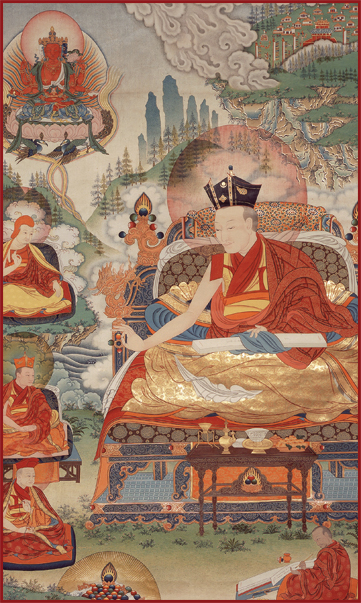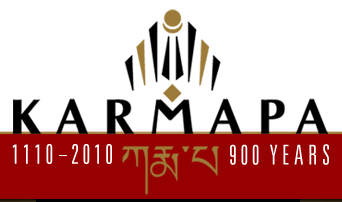For 300 years, the Gyalwang Karmapas moved freely across the wide open spaces of Tibet, accompanied by a vast mobile practice community known as the “Great Encampment of the Karmapa” or “Karme Garchen.” While they did visit major Karma Kagyu monastic seats along the way, the Fourth through the Ninth Karmapas spent the majority of their adult lives on the move, traveling to wherever they saw opportunities to be of benefit.
This unique institution of the Great Encampment allowed the Karmapas to move or stay put at will, setting up camp when conditions were right and continuing on when they were not. Yet unlike an ordinary camp, the determining factor was not what the location offered to those camping. Rather, it was what the camp could offer to the location, for the Great Encampment was effectively a vast means of reaching out to offer the Dharma in whatever place was then most receptive to it.
Indeed, the Great Encampment reproduced the Buddha’s mendicant manner of spreading the Dharma as he moved freely about northern India—while adapting the practice for the thinly populated Tibetan plateau.
As they travelled in the company of the glorious head of the lineage, the Gyalwang Karmapa, members of the camp continued to engage in intensive study and practice. In its heyday, the Great Encampment included within it a full-scale institute for philosophical study (in Tibetan, shedra) and a tantric college. In addition, a series of solitary retreatants (in Tibetan, chog dra) engaged in intensive meditative practice, each housed in their own one-person tent. At its peak, the Great Encampment was home to a full 500 such roving retreatants. At the same time, a large number of the philosophical treatises and meditation manuals composed by the Karmapas during this period were written within the precinct of the Great Encampment.
Drawing on Tibet’s deeply rooted nomadic tradition, the encampment carried all it needed with it as it traversed the valleys and high passes of Tibet. Even when the Gyalwang Karmapa himself might be hosted in a local monastery, the Great Encampment could situate itself nearby without placing an undue burden on the Karmapa’s hosts.
The mobility of the camp and its self-sufficiency allowed for a high degree of flexibility and spontaneity as well. From the time of the Seventh Karmapa, who founded the Kagyu Monlam Chenmo, the Kagyu Monlam itself was not fixed to any particular location, as it is today in Bodhgaya, but was simply held wherever the Great Encampment happened to be situated when the date for Monlam arrived.
Yet the Great Encampment was not simply an immense monastery on the move; it constituted a cultural institution unto itself. Every single person who joined the Great Encampment—even if only there to serve as a porter—was required to have completed certain minimal practice commitments, such as the accumulation of specific mantras. More broadly, the Great Encampment became renowned for its strict adherence to rules of discipline, which were enforced within the camp by a team of 30 full-time disciplinarians.
Almost incredibly, the Great Encampment defied the dependence on meat consumption that is integral to nomadic life on the arid Tibetan plateau. From the time of the Fourth Karmapa, who instituted it, until the Tenth, who witnessed its final destruction by Mongolian forces, the Great Encampment was completely vegetarian. For 300 years, it was strictly forbidden to even bring meat onto the encampment grounds, earning the Great Encampment the epithet of “The Buddhadharma of White Soup,” with “white” indicating that it was free of meat products.
From the art produced within it, it is clear that the Great Encampment offered a propitious climate for unbounded imagination. The Karma Kagyu lineage in general already placed a high value on artistic production, but the Great Encampment offered particularly fertile ground for creative output. The camp evidently included mobile artists’ studios, for one of the three major schools of Tibetan painting emerged from within it, and became known as the Karmapa Encampment Style, or Karma Gardri in Tibetan.
During the three centuries it thrived, the Great Encampment served as an enormously vibrant and effective site for the production of art, scholarship and, most importantly, spiritual realization. Its unique form was profoundly rooted in the teachings of the Dagpo Kagyu lineage of Buddhism itself, combining the Kadampa instructions for enhancing renunciation and bodhichitta with the fresh spontaneity yielded by Mahāmudrā practice.
The Great Encampment was established by the Fourth Karmapa, Rolpe Dorje, in the 14th century. When the number of people following the Karmapa and his entourage from place to place had grown unwieldy Rolpe Dorje alighted on the idea of organizing his followers into a structured encampment. The Great Encampment reached its peak during the time of the Seventh Karmapa, Chödrak Gyatso. The size of the Great Encampment—then numbering in the thousands—was scaled down to more manageable proportions by the Eighth Karmapa, Mikyö Dorje. In the 17th century, during the lifetime of the Tenth Karmapa, the encampment was attacked and its inhabitants slaughtered by Mongolian forces. The Tenth Karmapa only managed to escape with his life by flying off for parts unknown. After the Great Encampment was thus destroyed, subsequent Karmapas largely remained in residence at Tsurphu Monastery.
From the First Karmapa’s creation of the Tibetan institution of reincarnation lineages to today’s transmission of Dharma teachings live over the Internet, whenever existing means were inadequate, Karmapas have consistently found new ways of connecting with and caring for their disciples. For centuries, the Great Encampment served as an ideal means for Karmapas to reach their disciples wherever they might be, extending the range of their activities beyond each new horizon that presented itself. Defying the boundedness of place, the Great Encampment was a perfect manifestation of the Karmapas’ quintessential quality of unbounded activity for the sake of beings.
|
|
|||
 The Eighth Karmapa, Mikyö Dorje, spent much of his adult life moving across Tibet—teaching, composing texts and guiding his disciples—in the company of the Karmapa Great Encampment.
|
Karmapas' Contributions to Art, Culture and History THE GREAT ENCAMPMENT |
||



